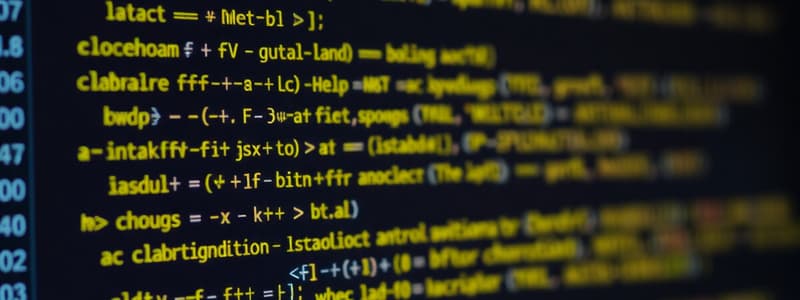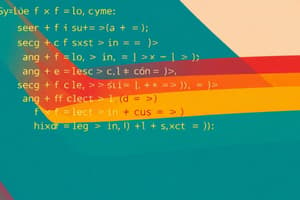Podcast
Questions and Answers
What logic does the control structure analyze to determine the flow of a program?
What logic does the control structure analyze to determine the flow of a program?
- User preferences
- Hardware specifications
- Certain conditions (correct)
- Data type analysis
Which option correctly describes sequential logic?
Which option correctly describes sequential logic?
- Flow that repeats a set of instructions
- Flow that analyzes data types
- Flow that executes instructions in a specific order (correct)
- Flow that makes decisions based on conditions
In the described scenario with Alice, Carol, Brian, and David, who is seated opposite from Brian?
In the described scenario with Alice, Carol, Brian, and David, who is seated opposite from Brian?
- David (correct)
- Carol
- Alice
- None of the above
Which control structure is used to create decision-making statements in C++?
Which control structure is used to create decision-making statements in C++?
What type of selection involves conditions that can lead to multiple outcomes?
What type of selection involves conditions that can lead to multiple outcomes?
Flashcards
Control Structures
Control Structures
Structures that determine the order of execution in a program.
Selection Logic
Selection Logic
A type of control structure where a program's flow depends on conditions.
if...else statement
if...else statement
A programming construct used to execute different blocks of code based on conditions.
Relational Operators
Relational Operators
Signup and view all the flashcards
Logical Expressions
Logical Expressions
Signup and view all the flashcards
Study Notes
Course Information
- Course code: CSC 1060
- Topic: Control Structures: Selection
Objectives
- Create decision-making statements in C++ programs using if-else statements with different forms.
- Use logical expressions in a program.
- Explain program flow.
Agenda Week 5
- Logic problem: Square Table
- Control Structures
- Relational Operators
- One-way & Two-way Selection
- Multi & Nested Selection
- Compound operators (|| & &&)
- Review: Multiple Choice Questions
- TODO & Resources for help
Logic Problem (Square Table Example)
- Four people (Alice, Carol, Brian, David) seated around a square table.
- Alice: Skater; Carol: Gymnast; Brian: Swimmer; David: Tennis player
- Swimmer sat to Alice's left.
- Gymnast sat across from Brian.
- Woman sat next to the skater's left.
Control Structures
- Control structures define the flow of a program based on specific conditions.
Overview of Control Structures
- Three types of logic/flow control:
- Sequence: Sequential flow of instructions (previous week).
- Selection: Conditional flow (current week).
- Iteration: Repetitive flow (next week).
Relational Operators
- Relational operators compare values to evaluate to either TRUE or FALSE.
- Examples: == (equal to), != (not equal to), < (less than), > (greater than), <= (less than or equal to), >= (greater than or equal to).
Selection (Decision Making)
- One-way selection: if statement: Conditional code execution if condition is true. (Do not write empty code blocks).
- Two-way selection: if-else statement: Conditional execution of different codes for true and false.
- Multi-way Selection: if-else if-else statement: Conditional execution of different codes based on multiple conditions. Nesting of if-else statements is possible.
Compound Operators
- Logical AND (&&), OR (||) combine relational expressions (conditions)
Review Questions
- Complete multiple-choice exercises (4.11).
- Complete exercises 1 to 8 (Skipping exercises 9 and 10 on recursion).
Pre-work Challenge
- Although exercise is in Python try to solve using the principles related in this module.
TODO List for Week 5
- Complete Week 5 Content Module in D2L to 100%.
- Post discussion question and research solution on D2L.
Help Resources
- Student Office Hours (by Appointment/Drop-in): On campus/Zoom.
- Email: [email protected]
- RRCC On-Campus Tutoring: https://www.rrcc.edu/learning-commons/tutoring
- 24/7 Online Tutoring: Available via D2L.
Studying That Suits You
Use AI to generate personalized quizzes and flashcards to suit your learning preferences.




